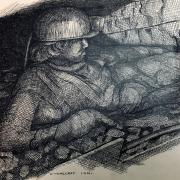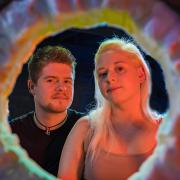In a fame-obsessed 21st century, a new exhibition features a ‘celebrity’ from an age before mass media or photography...Wirral’s own Emma Hamilton. Words by Paul Taylor.

She was the daughter of an illiterate blacksmith from a dismal coalmining village on the Wirral peninsula. But Emma Hamilton went on to become a titled lady, a friend of royalty, an artist’s muse, a performer of international renown.
Yet the lingering impression of Emma is of the siren who lured Britain’s greatest ever naval hero Admiral Lord Nelson.
‘By many Victorian authors, she was represented as the temptress who had ensnared the hero and threatened to pull him away from duty and heroism,’ says Quintin Colville, curator of an upcoming exhibition Emma Hamilton: Seduction and Celebrity, and editor of a new book of the same name.
But, rather than temptress and hapless victim, Emma and Nelson’s relationship was ‘one of real mutuality and joint respect’, says Colville. And there was far more to Emma’s achievements than merely bedding an illustrious seadog.

‘Obviously, she lives a life of sensuality and passion, but that is only one component of a broader and more serious existence,’ says Colville, who seeks, through the exhibition, to restore Emma’s reputation as a figure of national importance in her own right.
But the life and early death of Emma also tells us about ‘the appalling shelf life of female celebrity in that age and probably in this age as well,’ says Colville. ‘A lot of Emma’s cultural cachet was built around her physical beauty. As an older woman, she didn’t have the line of artists waiting to turn her into iconic images.’
Emy Lyon was born in 1765, daughter of blacksmith Henry, who worked at Denhall coal mine and who died within weeks of Emy’s baptism at Neston Parish Church. Her mother Mary took Emy to live with her own parents in Hawarden. Very little is known of Emy’s early years, though the family was reputedly so poor that Emy sold handfuls of coal by the roadside.
By the age of 12, she was working as maid to a doctor in Chester, after which she and her mother moved to London, working in theatres and then in a strange quasi-medical establishment where, posing in flimsy garments as Hygieia, goddess of health, Emy attracted the attentions of a string of aristocratic men. Along the way, Emy Lyon became Emma Hart.

‘She is having to play the game that women in the 18th century were often forced to, which is to make themselves sexually desirable to men who had power and authority and the ability to transform their lives,’ says Colville. ‘In that respect, Emma is no different from thousands of others.’
At 16, she had a child, also Emma, by one aristocrat, but gave up the child as a condition of being taken in by another gentleman Charles Greville MP.
Two years later, Greville sent Emma to his uncle Sir William Hamilton, the British envoy in Naples. Only later did Emma realise that Greville had palmed her off on his uncle, intending her to be his mistress.
But Emma made a success of the arrangement, marrying the much-older Sir William, embracing her life in Italy, performing her ‘attitudes’ - dramatic evocations of classical myth - to rapturous applause and befriending Maria Carolina, Queen of Naples and Sicily.

When Nelson evacuated the Hamiltons and the Neapolitan royal family to Sicily to escape Napoleon’s forces in 1798, the affair between Emma and Nelson began. Sir William acquiesced in what now seems a very modern arrangement. The three travelled back through Europe to Britain together, Emma pregnant with Nelson’s child, and set up home together.
‘It was not a ménage à trois marked by bitterness,’ says Colville. ‘I do think there was a deep affection going in every direction. Nelson, Emma and Sir William remained very close friends even in the context of the affair, even in the context of the child (Horatia). They were both at Sir William’s bedside when he died in 1803.’
Two years later, Nelson died at Trafalgar on October 21 1805, having added a codicil to his will that very morning, asking the nation to provide for Emma and Horatia. That nation, for which Nelson gave his life, ignored its hero’s last wish. Attempting to help Nelson’s friends and family, and maintain the home they shared in Surrey as a monument to the great man, Emma lived well beyond her means and was committed to prison for her debts.
Nelson’s letters to Emma had been stolen and were published in 1814, sealing her public reputation as the scarlet woman.
Released from prison, Emma fled to Calais where, increasingly reliant on alcohol, she died on January 15 1815 of dysentery. Horatia, for whom Emma craved respectability, got her mother’s wish. She married a clergyman, had eight children and lived a quiet life in rural Norfolk.
As history was being written in the more censorious Victorian era which followed, Nelson’s reputation rose further while Emma became an ever more inconvenient truth in the hero’s life.
Far from the scarlet woman, Emma’s remarkable rise to prominence was proof of a family background which ‘prioritised determination, education, self-improvement’, says Colville. ‘Even in her teens she seizes every chance she can get to improve her lot, to improve her mind. This really flowers in Naples where she exploits every educational resource that Sir William Hamilton can throw at her: languages, singing, the arts, theatre - she hoovers it all up.
‘She has a tenacious desire to be a respectable and knowledgeable woman, and she passes that on to her daughter Horatia as well.
‘But she was never accepted, even in Naples. Elite society in Britain would never think of Emma as one of them. Because of her humble origins, it was not possible. The best Emma could hope for was praise and tolerance and grudging respect. Nothing she could do would make her one of the beau monde.’
Emma’s tragic end
Emma Hamilton died in poverty, weeks short of her 50th birthday, having fled to Calais to escape her creditors. Because of the penury of her later life, the surviving stock of Emma’s possessions is limited. Yet the National Maritime Museum has assembled 200 objects for this exhibition - many never previously seen in public - including paintings, letters, costumes and jewellery.
Among the correspondence in the exhibition is a heart-rending letter Emma wrote begging Charles Greville to take her under his wing after she had fallen pregnant, aged 16, by another nobleman, who had promptly dumped her. Greville did take her in, but the price she paid was to give up the child, Emma Carew.
The artworks include paintings by George Romney - who called Emma ‘the divine lady ... superior to all womankind’ - Sir Joshua Reynolds and Sir Thomas Lawrence, all of which made her an 18th century celebrity.
Personal possessions include one of the betrothal rings exchanged by Emma and Nelson, and items belonging to their daughter Horatia. A hand-written message in a religious book given by Emma to Horatia tells us that she did not want her daughter to enjoy - or endure - the kind of celebrity which had been Emma’s fate. The inscription reads: ‘A life well spent makes old age pleasant and honourable and I hope my dear Horatia will be good, virtuous and improve her time.’
See this exhibition
Emma Hamilton: Seduction and Celebrity, runs at the National Maritime Museum, Greenwich, London SE10 9NF from November 3rd to April 17th 2017.
See www.rmg.co.uk for details.



























